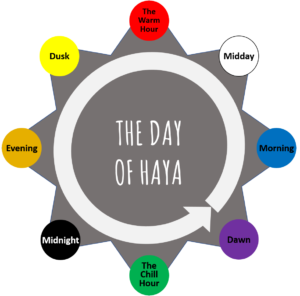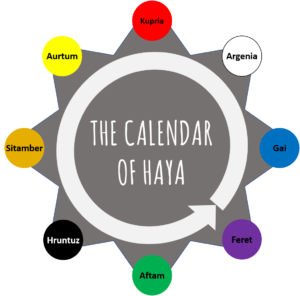Time
Haya differs from our own world in several ways other than the magic and the monsters and the map. On of the primary ways is the passage of time, based on the elements.
 The Hours of the Day. The Hayan day is the same length as ours, but is divided into eight hours rather than twenty-four. The peoples of Haya are not as precise in their measurement as we are, but the eight hours are roughly:
The Hours of the Day. The Hayan day is the same length as ours, but is divided into eight hours rather than twenty-four. The peoples of Haya are not as precise in their measurement as we are, but the eight hours are roughly:
Dawn (4:30 a.m. – 7:30 a.m.) ruled by lightning
Morning (7:30 a.m. – 10:30 a.m.) ruled by air
Midday (10:30 a.m. – 1:30 p.m.) ruled by light
The Warm Hour (1:30 p.m. – 4:30 p.m.) ruled by fire
Dusk (4:30 p.m. – 7:30 p.m.) ruled by metal
Evening (7:30 p.m. – 10:30 p.m.) ruled by stone
Midnight (10:30 p.m. – 1:30 a.m.) ruled by dark
The Chill Hour (1:30 a.m. – 4:30 a.m.) ruled by water
 The Days of the Week. The week is similarly made up of eight days which are usually named for the elements or the gods of those elements.
The Days of the Week. The week is similarly made up of eight days which are usually named for the elements or the gods of those elements.
Among the Yuta, the days are:
Vrisha Day, feast day for Tadomans (Weri Day among Adya) Storms are particularly ominous
Tiyi Day, feast day for Atzot (Buruy Day among Adya) Winds are particularly auspicious
Lasuzni Day, feast day for Wesadhi (Buji Day among Adya) Clear skies are particularly auspicious
Jelaye Day, feast day for Inet (Wetawaia Day among Adya) Fires should be started
Busvam Day, feast day for Divesh and Masya (Laia Day among Adya) Market day
Ansa Day, feast day for Tydhem (Hamei Day among Adya) Mines should be started
Mirri Day, feast day for Sihut (Jabi Day among Adya) Clouded skies are particularly ominous
Mai Day, feast day for Tudvam (Hutiya Day among Adya) Wells should be dug
 The Weeks and Months of the Year. Each month has eight weeks, 64 days per month, and the weeks are similarly named for the elements or gods. There are eight months in the year, making up 512 days per year. The equinoxes and solstices fall on the 32nd of the months of the seasons, on Mai Day of Jelaye Week. The Yuta names of the months are:
The Weeks and Months of the Year. Each month has eight weeks, 64 days per month, and the weeks are similarly named for the elements or gods. There are eight months in the year, making up 512 days per year. The equinoxes and solstices fall on the 32nd of the months of the seasons, on Mai Day of Jelaye Week. The Yuta names of the months are:
Feret, the lightning month of spring, when the rains become thunderstorms.
Gai, the air month, when the winds of summer pick up.
Argenia, the light month of summer.
Kupria, the fire month, hottest month of the year.
Aurtum, the metal month of autumn.
Sitamber, the stone month, the dry season.
Hruntuz, the dark month of winter, when light falls from the sky in the form of snow.
Aftam, the water month, when the heaviest snows and rains fall.
Years are also organized in eight-year groups (kezpan among Yuta, weladrau among Adya), each year dedicated to one of the elemental gods. There are twelve and a half of these great-years per century.
The Skies. The ecliptic of Haya (the path of the sun, moon, and planets through the sky) passes through eight constellations representing the elements: The Eagle (lightning), The Goose (air), The Dove (light), The Fox (fire), The Lion (metal), The Bull (stone), The Snake (dark), and The Fish (water). There is also a pair of constellations in the north called The Bear and The Elephant (or Mammoth) which converge on the world’s pole star.
The passage of the sun through the elemental signs mark the months of the year. At the discretion of the gaming group, being born in a particular month could grant a character bonuses in resistance or casting spells related to the element the month governs. The largest “wandering star” (planet) in the sky is known as Khifeos among the Yuta, and passes from one sign to the next starting on New Year’s Day (the first of Feret) giving each year of a great-year its element.
 Haya also has three moons.
Haya also has three moons.
The largest is known as Tyura among the Yuta and Bulang among the Adya. Its passage through the signs of the ecliptic mark the eight weeks of the month.
The second largest, Desema among the Yuta and Zasali among the Adya, is about 1/5 as wide as Tyura in the sky, and passes through the signs over the week, marking the days.
The smallest moon, Suza among the Yuta and Ura among the Adya, is a small, reddish, oblong moon that swings swiftly through the skies once/day, marking the hours.
Magical Influences. Most magic in Haya is closely tied to the elements, regardless of the type of magic, because even the gods are defined by their elemental influence. Thus magic is highly influenced by “the stars” that determine the calendar.
For this purpose, all cold-oriented spells are considered to be governed by water, and spells aiding or supporting the undead are considered dark magic. Those causing fear, panic, or confusion are considered governed by lightning. Spells allowing flight or levitation are governed by air. Those bringing knowledge (or opposing the undead) are considered light magic. Spells causing haste or warm/hot emotions are governed by fire. Those affecting charm or adoration are governed by metal. Spells providing strength or endurance are governed by stone.
Elemental magic enjoys a bonus of +1 to success and effect per die if cast on the day, week, month, or year of its element, a maximum +4, but also suffers a penalty of -1 on the day, week, month, or year of its opposite. The bonuses and penalties, of course, count against each other. The “per die” effect means that a +2 bonus on a 2d8 roll awards +4 total.
